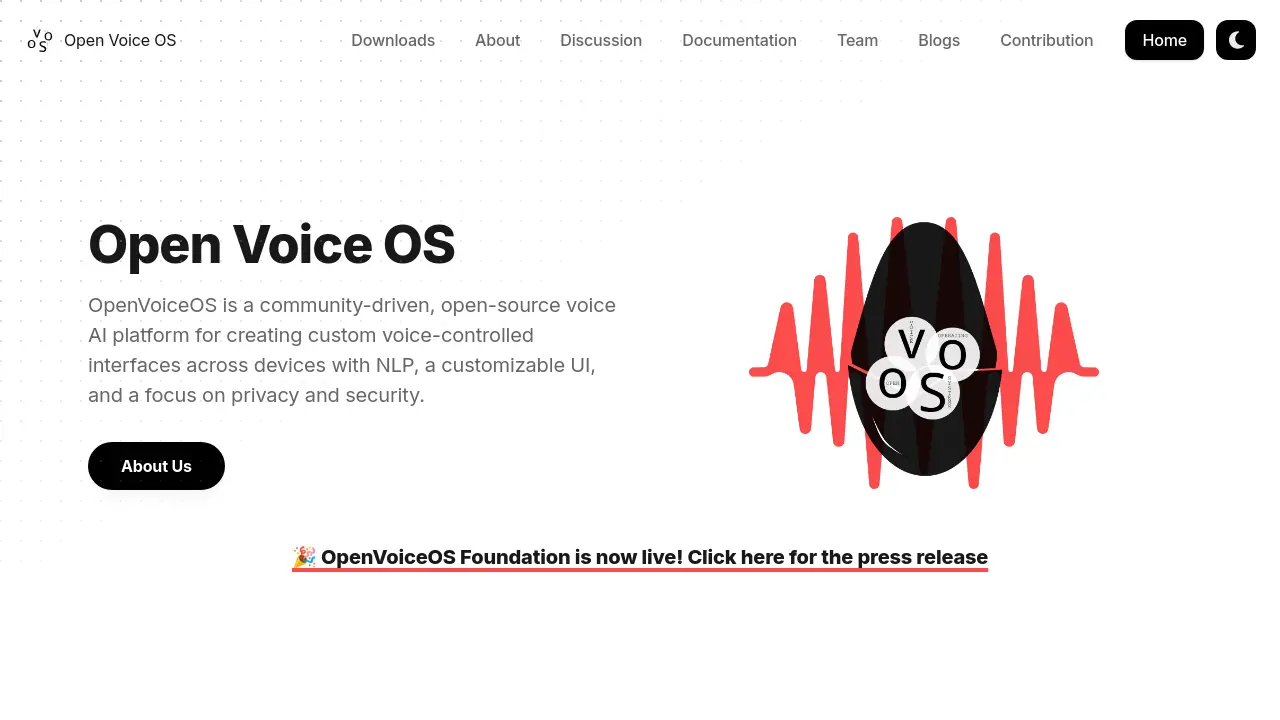openvoiceos.com
Community-driven, open-source voice AI platform for custom voice interfaces.

Description
Open Voice OS (OVOS) is a versatile, open-source voice AI platform developed collaboratively by a global community. It provides the tools necessary to build custom voice-controlled interfaces suitable for a wide range of devices, from embedded systems and single-board computers to DIY smart speakers. The platform prioritizes user privacy and security in its design.
Originating as a community initiative and evolving independently, OVOS offers flexibility for developers. It supports multi-platform deployment and encourages experimentation with cutting-edge voice assistance technology. While compatible with elements of the Mycroft ecosystem, OVOS maintains its own enhanced core functionalities and welcomes contributions for specific device support or feature development.
Key Features
- Community Driven: Developed and maintained by a global community of developers.
- Open-Source: Freely available source code allowing for modification and distribution.
- Multi-platform Support: Deployable on various hardware, including embedded systems, single-board computers, and headless devices.
- Customizable UI: Enables the creation of tailored voice interface experiences.
- NLP Integration: Incorporates Natural Language Processing for understanding voice commands.
- Privacy and Security Focus: Designed with user data protection as a core principle.
- Experimental Core: Serves as a platform for testing and developing new voice AI features.
- DIY Friendly: Encourages contributions for supporting specific devices and platforms.
Use Cases
- Creating custom voice-controlled interfaces for devices.
- Building DIY smart speakers.
- Developing voice assistants for embedded systems or low-spec hardware.
- Experimenting with and contributing to voice AI technology.
- Integrating privacy-focused voice control into products.
- Developing offline or self-hosted voice solutions.
Frequently Asked Questions
How did Open Voice OS start?
Open Voice OS started as MycroftOS and was later renamed. Initially focused on bundling Mycroft-core, it now maintains an enhanced reference fork due to upstream contribution challenges, acting like an unsanctioned 'Mycroft Community Edition'.
What is the relationship between Open Voice OS and Mycroft?
The projects are fully independent. Open Voice OS evolved from wrapping Mycroft-core to creating its own Open Voice OS-core for faster development, while remaining committed to component compatibility and submitting changes back to Mycroft.
Does Open Voice OS work offline?
By default, the core (ovos-core) doesn't require an internet backend server. Some skills can work offline. However, the default Speech-To-Text (STT) needs internet, though self-hosted, offline options are available. Many skills and plugins may also require internet access.
How can I contribute to Open Voice OS?
Contributions are welcome in various forms, including testing, reporting bugs, writing documentation, creating skills, and contributing code. The documentation provides guidance on how to get started.
You Might Also Like
ProfileCritiques
Usage BasedGet More Matches with AI Profile Reviews
Oraczen
Contact for PricingRewiring Enterprises with Agentic Systems
AmyMind
FreemiumAI-Powered Text and File to Mind Map Generation
LandingTrack
Free TrialAutomated Affiliate Tracking and Optimization Platform
WPTurbo
FreemiumGenerate WordPress code snippets blazing fast.